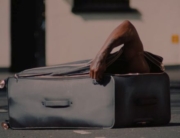Almost four decades in the making, this affectionate film is both an illuminating portrait of writer Kurt Vonnegut and a touching story of a friendship that developed between the filmmaker and his subject. Planning a conventional biographical documentary, director Robert B. Weide (Curb Your Enthusiasm) initially had not wanted to be on screen. “I don’t even like documentaries where the filmmaker has to put himself into the film,” he says in an interview with co-director Don Argott (The Art of the Steal), who was recruited to tell Weide’s side of the story. “But why it took 40 years to finish the film requires an explanation.”’
Introduced to Vonnegut’s Breakfast of Champions (1973) in high school, Weide became obsessed with the novelist. In 1982, after completing his first film, at the age of 23, about the Marx Brothers, the filmmaker reached out to the author, proposing a documentary about his life and work, but Weide only began filming in 1988. Over the next 30 years, he was also sidetracked by other filmmaking projects.
Incorporating crisp black-and-white home movie footage provided by Vonnegut’s brother, Bernard, along with interviews with Vonnegut, his family, Vonnegut scholar Jerome Klinkowitz, and literary critics, the film follows the writer’s life in a scattered chronology that jumps back and forth in time. A 1994 visit to his Indianapolis home, designed by his architect father, finds the septuagenarian writer reflecting on his childhood as he touches the still-visible concrete imprints of his child-size hand and the hands of other family members. “It doesn’t make me sad at all,” says Vonnegut, “because it was such a happy time.”
But that blissful period ended with the Great Depression, and then came World War II, his depressed mother’s suicide in 1944 (revealed later in the film), and Vonnegut’s harrowing experiences as a prisoner of war surviving the 1945 firebombing of Dresden. In interviews, Vonnegut denies he felt anything. “The neighborhood dogs where I grew up had more impact on me than Dresden.”
However, in tracing Vonnegut’s struggles to become a writer on Cape Cod, the documentary reveals how the Dresden experience haunted early work like Cat’s Cradle (1963). It’s only after he wrestled with draft after draft of what would become his masterpiece that Vonnegut finally cracked the code to tell the Dresden story. “It was as if he was trying to purge the whole experience from his soul once and for all,” notes Weide in a voice-over.
The 1969 publication of the anti-war novel Slaughterhouse-Five, at the height of the Vietnam War, brought money and celebrity, and Vonnegut quickly became a New York literary darling. Starting a relationship with a young photographer named Jill Krementz ended Vonnegut’s long marriage to the supportive Jane Cox. “Until he died, I hated him,” says nephew Jim Adams. “I hated the way he treated Jane. He threw it all away.” (After the tragic deaths of Kurt’s beloved sister and her husband in 1958, Adams and his three brothers had been adopted and raised by the Vonneguts.)
As the film unspools Vonnegut’s complicated life, warts and all, snippets of Weide’s own personal life are inserted into the narrative, with shots of him sorting through the boxes of materials he accumulated and watching old footage he shot. (His house is filled with artwork drawn by Vonnegut.) Toward the end of Vonnegut’s life, Weide decides not to bring the camera when he visits the author at his summer home on Long Island: a turning point in the making of the project. “Rather than the friendship infringing upon the film,” he recalls. “I was worried for the first time about the film infringing upon the friendship.” It took Vonnegut’s death in 2007 to motivate Weide to finish the documentary.
One does wonder why the filmmaker did not include interviews with Vonnegut’s widow, Jill Krementz, and their adopted daughter, Lily. Did they refuse his requests? Or did his close relationships with Vonnegut and his two daughters from his first marriage affect his decision not to interview them?
Despite this omission, this lively, entertaining, and unconventional documentary, which seamlessly melds Weide’s original footage with Argott’s newer material, will give viewers a new appreciation of Kurt Vonnegut.

















Leave A Comment